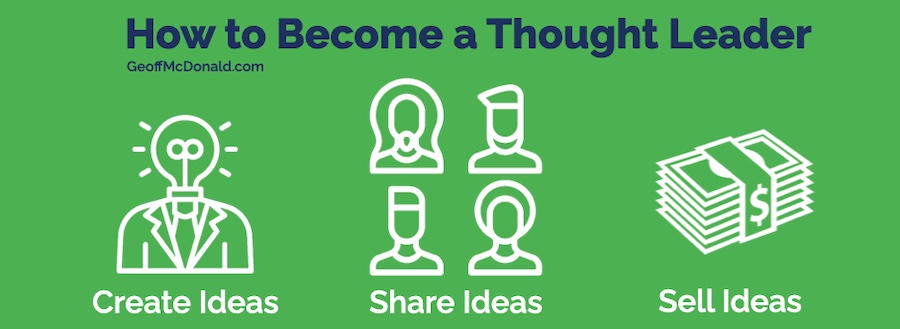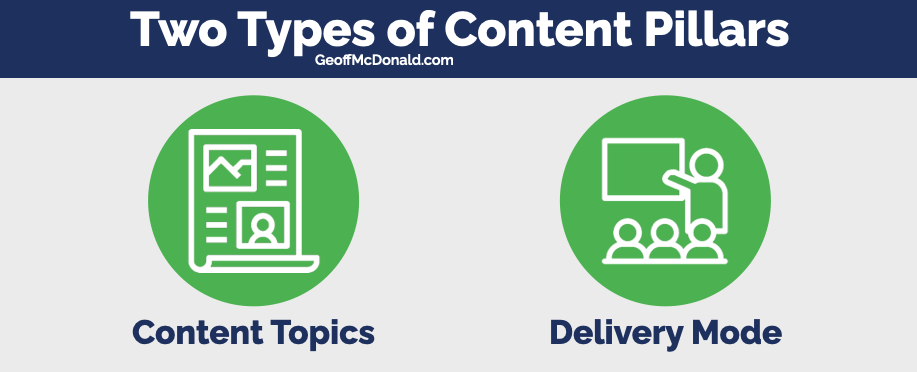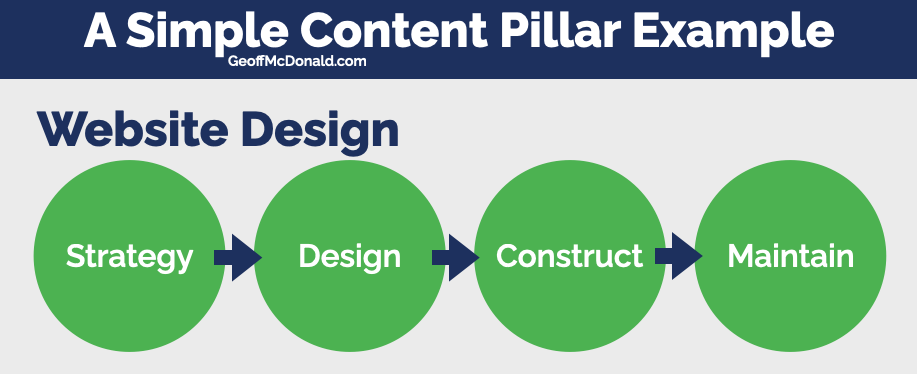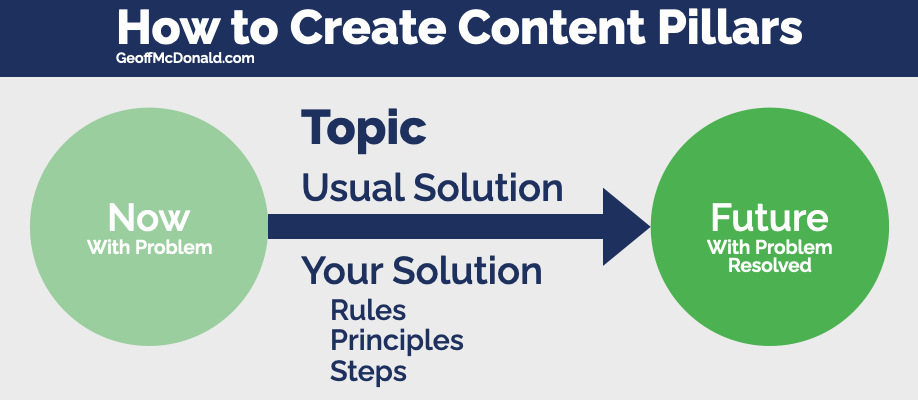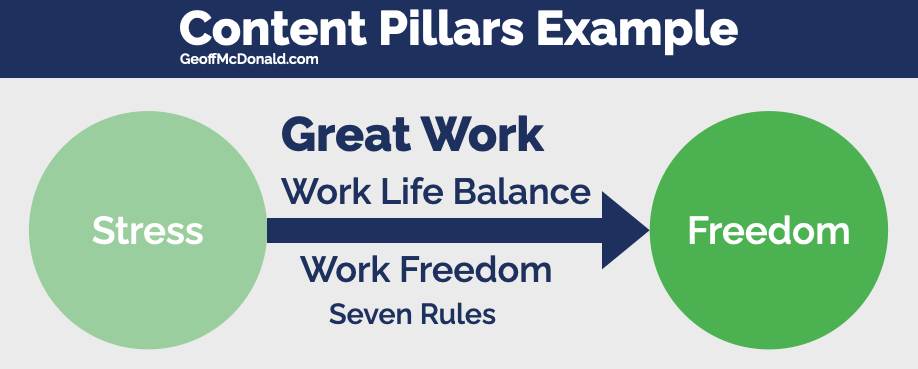Content Pillars are an essential strategy to becoming a thought leader.
To become a thought leader, you need to create thoughts, ideas, and insights. And it follows you need to share these with other people for them to recognise your expertise. In other words, to earn money from what you know you need to create and share content in some form.
This might be on social media, as content marketing, as keynote presentations, as information products or in writing books.
While this is good general advice, to take effective action we need to be more specific about how to do this.
The specific insider strategy for becoming a thought leader is to create Content Pillars. In this post, we’ll share what is a content pillar, examples of content pillars and how to create your own.
How to become a thought leader
In our earlier post, How to Become a Thought Leader we shared the three general things you need to build.
You need to create ideas, share ideas and sell ideas. In this post, we drill into the specifics of how to do this through creating your Content Pillars.
Why do you need Content Pillars?
One of the big challenges for many content creators is knowing what to create content about. And by defining your Content Pillars in advance, it gives you a map of a wide range of connected subjects.
Essentially, content pillars provide three layers of focus and clarity for:
- You – on what subjects to create content about
- Your audience – to know and understand your core expertise
- Search engines – to index and rank your content.
What are Pillars?

A pillar is a vertical support or column in a building. In a classic Greek temple, you have multiple pillars holding up the decorative frieze and roof of the building.
When applied to a person, we often say they are a ‘pillar of strength’ or a ‘pillar of the community’ which means they are an important piece or part of a group.
This is a perfect description for a thought leader – being a pillar of strength around a topic is what you’re aiming for.
What are Content Pillars?
A Content Pillar is generally defined as a core topic about which you write, speak or present. For example, if you look at the videos and blog posts, I have created recently you can see that two of my content pillars are around Thought Leadership and Content Creation. And this post combines both topics in a single article.
Content Pillars may also be known as:
- Topic Clusters
- Content Buckets
- Content Categories
- Pillar Page
In SEO, a Content Pillar has a more specific meaning. It’s typically a single piece of content that your other content points toward. This is often called a Pillar Page.
SLIDE: You might like to think of your Content Pillar pages as your sun and your other pages as satelites orbiting the sun.
In terms of becoming a Thought Leader, we’re talking about a Topic Cluster. For example, this might be change management, HR retention or mindset. Within this overarching topic, you will have your own special sauce and way of doing things. For example, in terms of content creation, my special sauce is around creating a manifesto.
Brand pillars versus Content Pillars
For thought leaders, it is crucial that you’re aware of your brand pillars and your content pillars.
A brand pillar refers to the key things that set your brand apart from your competitors. These are usually the touchpoints and brand experiences you provide. For example, these include your brand colours, your personality, or your design style.
For most businesses who sell physical products, like a jeweller or a health product, there is only a small overlap between their brand pillars and their content pillars.
But for a thought leader, your ideas (point of view) and your content are a crucial part of your brand. For thought leaders, you are your brand, and you are also your thoughts and brand ideals. And this means there is a strong overlap between your brand pillars and your content pillars. Being aware of this means you can take advantage of it.
Two Types of Content Pillars
Most product-based businesses only have to choose one type of Content Pillar – the content topics. But for a thought leader, they have to choose two types of Content Pillars. The simple reason here is that how you present your content makes a big difference in how potential clients view your services. For instance, if you are a keynote or conference speaker then showcasing your words is not as strong as if you are presenting on video. Plus, it’s not just about social media and content marketing for a thought leader – it’s also about delivering their content as part of their service offering.
1 Content Pillar Topics
First, you have your content topics. These are the topics you speak or write about and your opinion about how to be successful in those areas. Lots of people might talk about change management, but what sets you apart from the rest is your unique perspective and the actions you take to create success. (Coming up, I’ll share my six-part insider strategy for creating your content pillars.)
2 Content Pillar Delivery
The second type of content pillar is the form of your ideas or the way you deliver your content. The key here is to define your go-to delivery styles. These may include:
- Live presentations at conferences
- Recorded video presentations (like this one) on YouTube
- Live group coaching sessions
- Training workshops
- Written content as blog posts (like this) and books
- Audio content as podcasts interviews
- Designed content in the form of visual models and infographics.
Ideally, the vehicle you use for your free content should mirror, model and promote your premium service offering. For instance, if you’re a speaker, then producing videos of you presenting is a good way to reinforce your speaking skills.
How to create content pillars – Two Marketing Approaches
There are two different ways to create your content pillars and they depend upon your marketing viewpoint.
1 Customer Persona or Avatar
The usual way is to create your content pillars is to identify your ideal customer, your customer avatar or persona. While it is helpful to know who the audience for your content is, I think there is a serious limitation to this approach.
2 Customer Jobs or Jobs to be Done
A different approach is to think about customer jobs or the jobs to be done. Instead of focusing on a person, you focus more on an issue or a challenge that people have.
A great example of this approach is the Swedish furniture company, Ikea. If you were to analyse their customer personas you have everyone from young adults to families and older couples. But if you look at their audience from a customer jobs perspective you have one role: to furnish housing quickly and cheaply with style.
In my view, that’s a better strategy for a thought leader because you want to base your brand on the problems you solve and not the people you serve.
A Simple Content Pillar Strategy
A really simple way to create content pillars is to say I’m going to create content around these things. For example, a website designer might have content pillars around:
- Strategy for website design
- Designing your website
- Building your website
- Maintaining your website
That’s four simple content pillars they can consistently create and share content around. And you might notice that these are the general services that a typical website designer might provide so it makes sense to be having these as your content pillars.
A Content Pillar Strategy for Thought Leaders
The strategy I use to create content pillars with my clients is more detailed and has six steps.
(I’ll share the six steps first, then I’ll showcase a content pillar example to show you how it looks in action.)
- Content Topic: Start with your topic. What’s your area of expertise?
- Current Situation: The problem or the now. Where is your client right now? What problem are they facing?
- Future Scenario: When the problem is resolved, what does this look like?
- The Usual Solution: How do most people tackle this problem?
- Your Solution: What’s your unique way of tackling this problem? It needs a specific name.
- Your Way: The rules, principles, or steps you use for solving the problem and taking people to their ideal future.
A Thought Leadership Content Pillar Example
That’s the six basic steps of the Content Pillar strategy for thought leaders. Now, let’s look at an example: This is something that I’ve been working on recently that I may publish as a small book.
- Content Topic: Managing work and life
- Current Situation: Many people are stressed out working long hours and not being able to switch off due to 24/7 digital access to work
- Future Scenario: While calm might be the opposite of stress, I believe what people really want is freedom, autonomy, and choice around how they live and work.
- The usual solution: Work/Life balance which presumes that your work and your life should somehow be equal. While this might suit people in jobs, I don’t think elite performers are looking for balance.
- Your solution: I prefer Work Freedom because your work can be a source of inspiration in your life that needs to be celebrated not balanced. This is the world of work as your calling or vocation.
- Your way: The Seven Rules of Work Freedom give you seven aspirations or goals across your work for you to free in your life and your work.
If you want more on Work Freedom and my seven rules, check out the post Work Freedom and True Work-Life Balance.
How many Content Pillars should you have?
The big question that most thought leaders and business experts want to be answered is, ‘How many content pillars should you have?’
I suggest you think about your expertise as your temple. You’re building one temple with multiple pillars. Then, if you use the six-part strategy that I’ve already shared, then you’ll have six primary content pillars.
But like a chef baking a cake, not all ingredients – your six pillars – will be used equally. You’ll use some more than others. For instance, if you look at the right-hand pillar it says ‘Seven Rules’ – so instead of one pillar, this could be seven pillars. These can be your secondary content pillars.
Ideally, you want one overarching topic and a handful of pillars – probably 5-7 is a general guide.
Summary: Content Pillars and becoming a Thought Leader
Here’s a quick summary of the key points you want to take away when creating your Content Pillars and becoming a thought leader.
- To be a thought leader you want to be seen as a pillar of strength around your area of expertise.
- Your content pillars provide clarity and focus about what content to create and share.
- Content pillars are the themes you talk about inside your area of expertise.
- For thought leaders, there is a strong overlap between your brand pillars and your content pillars because your ideas are a key part of your branding.
- There are two types of content pillars – the content or topics and the delivery mode or how you share your message.
- To create your content pillars, you can either focus on the customer persona or the customer jobs.
- Ideally, you want a handful of pillars – if you have too many you’ll dilute your brand.
More on Content Pillars
If you’d like more on creating content pillars and becoming a thought leader, here are some other pieces of content I’ve created and shared recently:
- How to Become a Thought Leader
- Thought Leadership Content Marketing
- Thought Leadership Content – What is a Manifesto?

